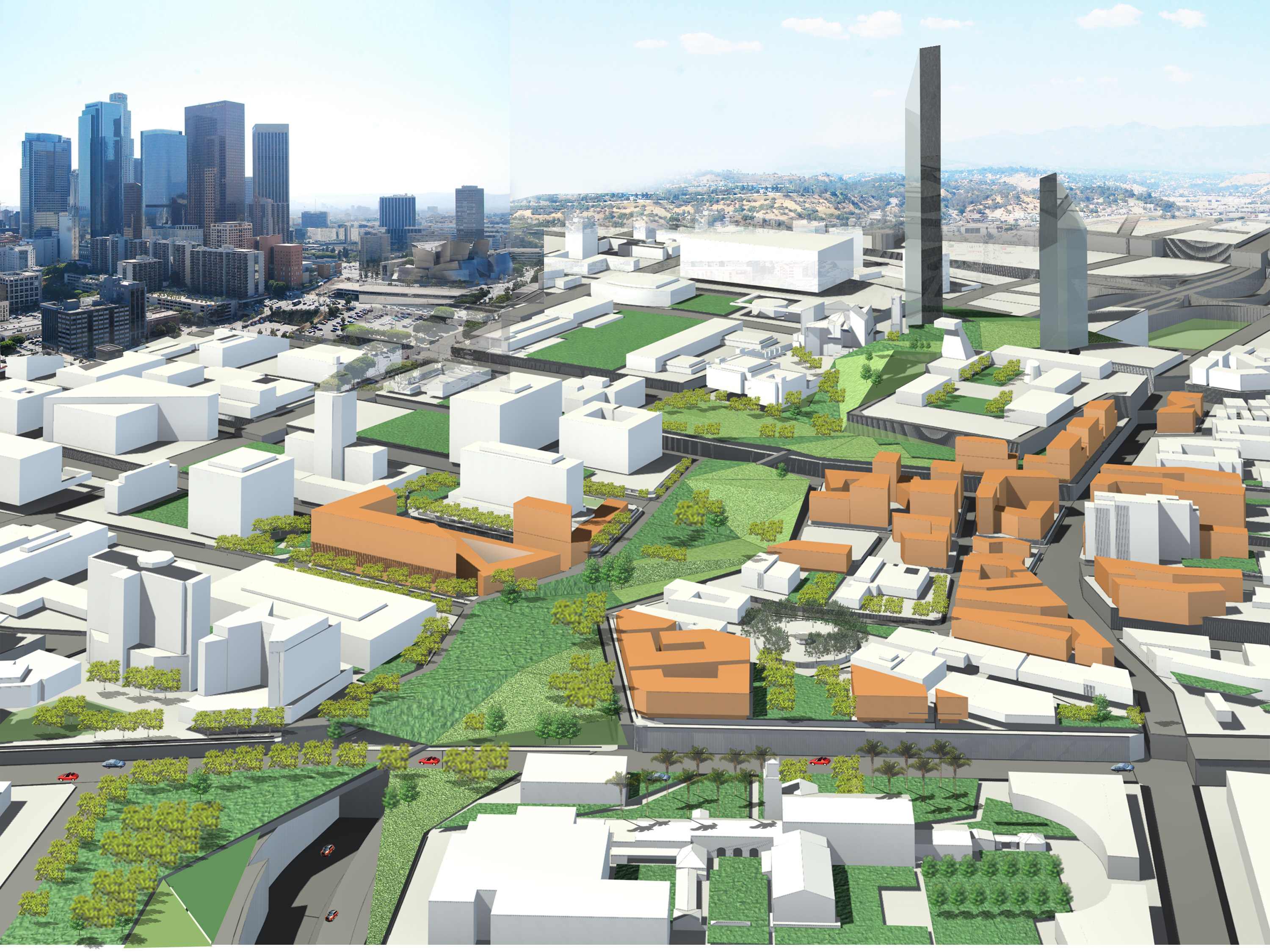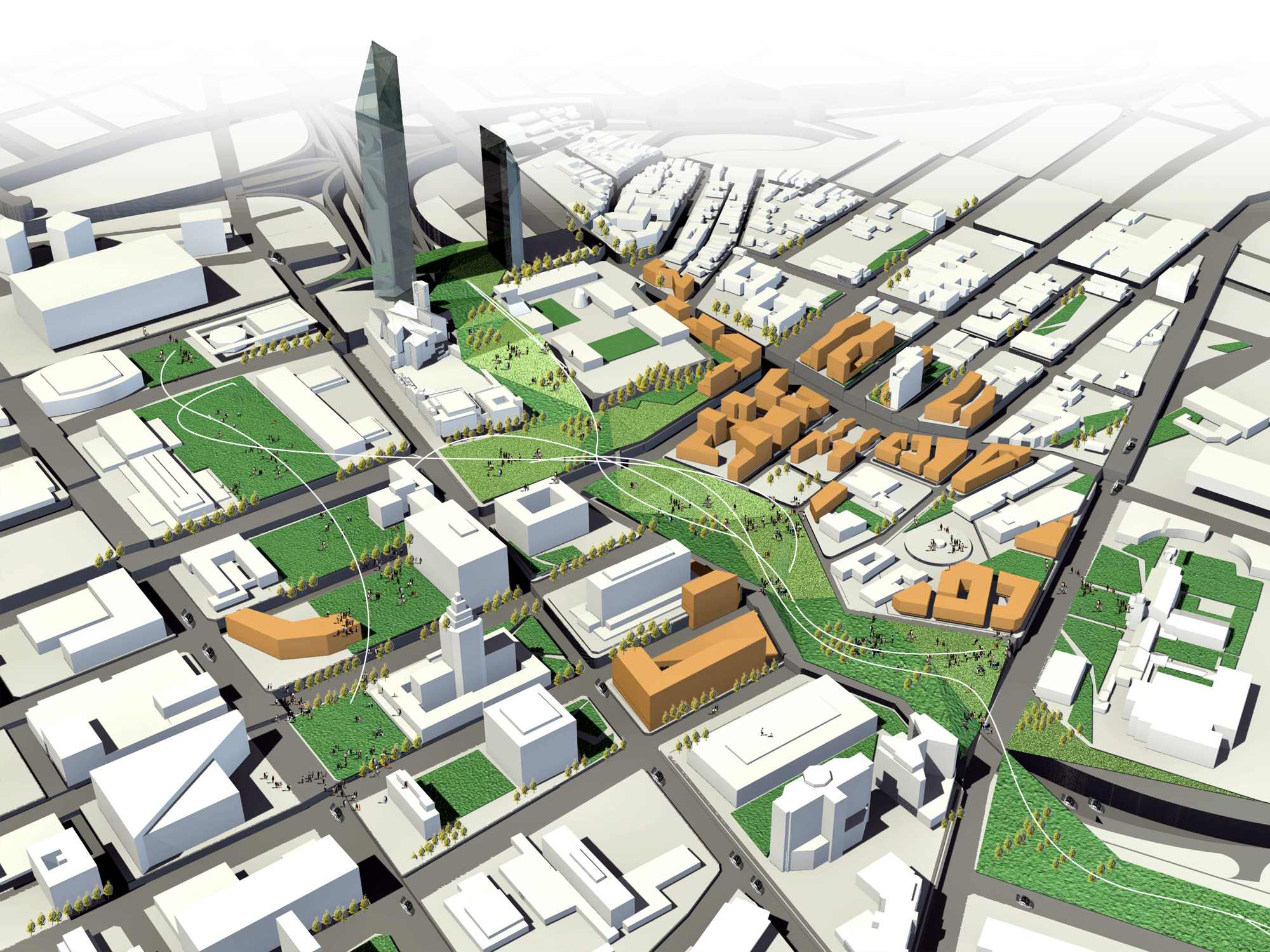We've all seen in recent weeks the cruelty of hurricanes uprooting houses as easily as trees, tossing cars into fields and reducing farms to rubbish heaps. Tropical storms go where they want, and anything less than monolithic masonry is a goner. Even with the damage they bring, however, hurricanes are kinder than freeways.
Freeways rip through existing cities like steel cables snapping at high tension, leaving impassable barriers and divided neighborhoods. And unlike the damage caused by hurricanes, the dead space of freeways cannot be repaired. The devastation is permanent; it is part of the landscape.
Only two exceptions are available to alter the impact of freeways: In the case of elevated roadways, we can take them down, as San Francisco did with the Embarcadero Freeway along the waterfront. And in the case of corridors located in trenches, we can build above them.
The latter strategy is the gambit of Park 101, a proposal to build a half-mile-long green swath above the Hollywood Freeway in downtown Los Angeles. The proposal, designed by 40 students interns under the supervision of EDAW, the national landscape architecture and planning firm, is to "cap off" the roadway and cover it with a roof of grass. On first impression, the Park 101 design is naïve, over-reaching, romantic, hopelessly optimistic. The scheme looks as if the angels who originally let Ireland fall from heaven one day had gotten a little tipsy and spilled some surplus buckets of celestial turf upon the concrete and asphalt of downtown L.A., saying, in their best brogue, "because the dear souls of the diocese seem to need it so."
After we get over the novelty of the design, we realize something else: Romantic and naïve or not, Park 101 is a great idea. The proposal remakes the ugly and unwalkable mess known as the Los Angeles Civic Center into a garden of delight. The new above-lanes walkway would create pedestrian links among a group of heretofore mutually isolated places – among them, the Los Angeles County buildings, the Los Angeles Cathedral and historic Olvera Street.
The walkway also sends out its green tendrils to other open spaces, most notably the 18-acre Grand Avenue Park, which is currently in design development a few blocks south of the freeway trench. The scheme reminds me, albeit loosely, of Frederick Law Olmstead's "Emerald Necklace," a linear system of loosely connected parks in Boston, not entirely unlike a linear park built atop a freeway, connecting a series of other downtown parks and open spaces.

The computer renderings of Park 101 remind me of those black-and-white optical tricks, in which the black lines and the white spaces around them trade places as foreground and background, teasingly asking us to choose which image is "real." Similarly, in Park 101 negative spaces of downtown, such as the dead air above the freeway, become positive green space, changing our mental image of downtown L.A. We can see spaces and spatial relationships previously unnoticed (at least by me), especially the way buildings located on either side of the Hollywood Freeway appear closer to one another when the chasm between them is filled in. As in the environmental art works of Christo and others, Park 101 takes a familiar landscape and makes it into something unfamiliar, and infinitely more attractive. The least appealing and least workable part of downtown could plausibly become its social center.
This is not to say that some parts of Park 101 are not jejune or even downright silly. The intern designers envision an amphitheater, which is a favorite device of landscape architects who love the look of terraced semicircles merging with earthworks, even though small amphitheaters are usually met with indifference by park users. More questionable is an urban forest to be planted atop the cap, although Mike Williams, one of the EDAW project managers, told me that five-foot deep berms may accommodate some tree roots. More questionable still is a parking structure to be located beneath the enclosure, at the freeway level. This sounds dark and hard to secure. And about the proposal for a place-marker tower with a pencil-like profile, foreseen as the tallest building west of the Mississippi. It deserves to be crumpled up in design student's waste basket, as surely it will be.
Engineering the enormous bridge seems the greatest challenge. Williams tells me there are precedents, although none as large as a half-mile long freeway bridge within the mile-long park. A five-acre, above-the-highway park exists in Seattle, and Williams said that EDAW's structural consultant, the Paris office of DMJM, has experience in designing analogous structures.

Beyond the politics of traffic and parking in Los Angeles, which are considerable, is the matter of cost, which I don't pretend to know. A similar proposal a few years back to cover a portion of La Cienega Boulevard in south Los Angeles had an estimated costs of several hundred million dollars. Park 101 would almost surely cost more. (EDAW did a feasibility study for another over-the-bridge in Hollywood that might provide a basis for estimating engineering costs.)
Charming or not, it would take the power of a gale-force wind to turn this scheme into something real beneath our feet. Transportation engineers must reroute much of downtown, where daytime traffic varies between slow and no-go. (Could an increase in foot traffic in the Civic Center reduce the need for cars?) The scheme would also require a long battle with entrenched interests (sorry, "stakeholders") although it is conceivable that the greenway would ultimately boost property values, justifying the public investment. In any event, we should begin troubleshooting this proposal immediately. Cities are impossible without freeways, and they are miserable places without walkable open space. Fanciful or not, Park 101 is worth building.

